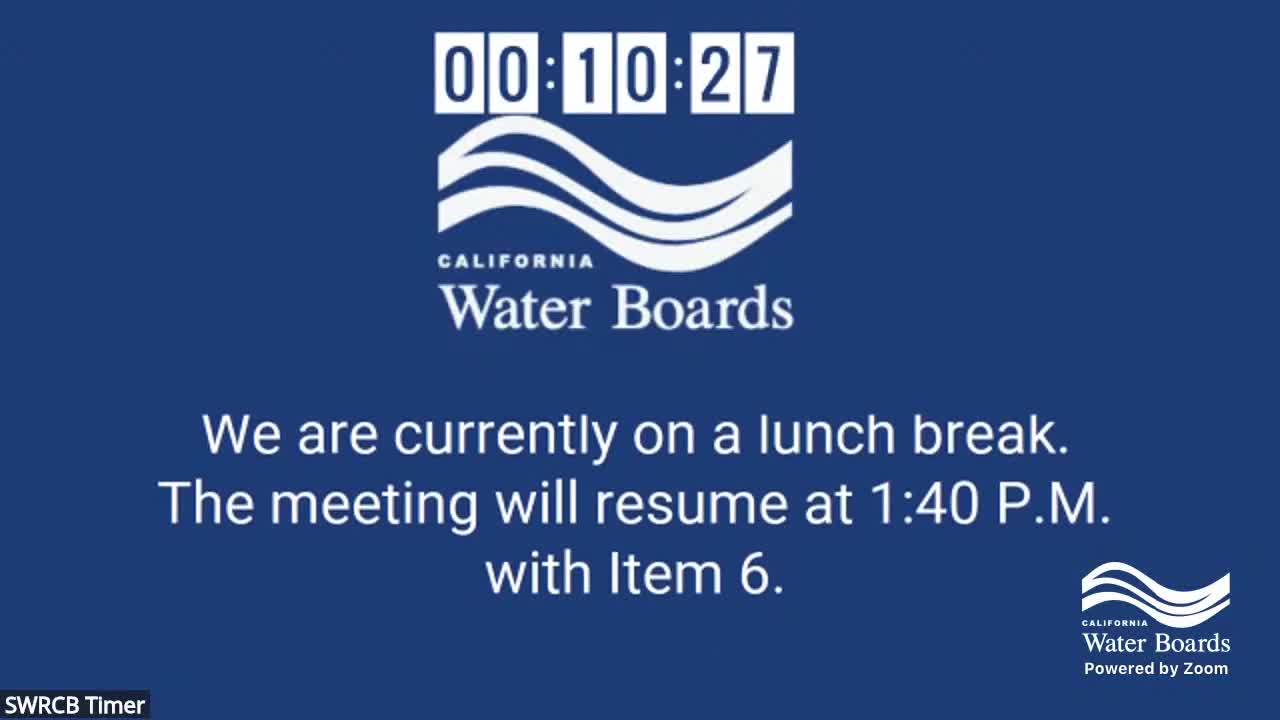State board adopts FY2025–26 SAFER fund plan; staff increases technical‑assistance and O&M targets and clarifies interim support for domestic‑well communities
November 04, 2025 | State Water Resources Control Board, Agencies under Office of the Governor, Executive, California
This article was created by AI summarizing key points discussed. AI makes mistakes, so for full details and context, please refer to the video of the full meeting. Please report any errors so we can fix them. Report an error »

The State Water Resources Control Board on Nov. 4 adopted its Fiscal Year 2025–26 fund expenditure plan for the Safe and Affordable Drinking Water (SAFER) program, updating program targets and clarifying interim assistance for domestic‑well and very small systems while increasing technical assistance and operation & maintenance (O&M) support.
Jasmine Wahaca of the Division of Financial Assistance summarized changes made to the draft plan in response to public comment and new information through June 30, 2025. Staff increased the technical assistance target to address greater demand and added a modest increase to operation & maintenance assistance; the construction target funded from the SAFER fund was slightly reduced with other funding sources (SRF, bonds and earmarks) available for construction projects. The plan added or clarified a domestic‑well / small water‑system strategy and indicated staff will pursue an implementation plan in 2026.
On interim assistance, staff revised draft language to clarify that the plan generally expects interim solutions to run up to two years, but that extensions may be considered for systems that are actively pursuing consolidation or a demonstrated long‑term solution. Staff also clarified that references to alternative compliance or mitigation programs do not change how those programs are administered. Officials said the SAFER plan defers to the Drinking Water State Revolving Fund intended‑use plan for planning and construction criteria while preserving deputy‑director discretion in specific cases.
Several Perry Colony residents (West Fresno County) told the board they have lived weeks to years without a functioning private well and rely on hauled or bottled water for household needs. Community members detailed the health and daily‑life stresses of rationing small deliveries and urged timely long‑term solutions. A Self Help Enterprises representative explained the program’s hauled‑water standard (about 50 gallons per person per day) and encouraged residents to contact project managers when deliveries appear short so staff can investigate and resolve problems.
Board members praised staff for responsive edits to the plan and for elevating the domestic‑well strategy. Several members emphasized the need for equity‑sensitive metrics for technical assistance and recommended flexibility in TA project milestones for disadvantaged or remote communities. The board also heard recommendations to develop a regional‑operator pilot and continue point‑of‑use/point‑of‑entry pilot projects to address short‑term needs while long‑term consolidations are pursued.
The board voted unanimously to adopt the FY 2025–26 SAFER fund expenditure plan. Courtney Tyler called a roll call; members recorded “aye” votes and the resolution was adopted.
Ending note: staff said it will continue to solicit TA provider feedback, complete an implementation plan for domestic‑well support in 2026, and work with partners (self‑help, GSAs, local agencies) to accelerate long‑term solutions for affected households.
Jasmine Wahaca of the Division of Financial Assistance summarized changes made to the draft plan in response to public comment and new information through June 30, 2025. Staff increased the technical assistance target to address greater demand and added a modest increase to operation & maintenance assistance; the construction target funded from the SAFER fund was slightly reduced with other funding sources (SRF, bonds and earmarks) available for construction projects. The plan added or clarified a domestic‑well / small water‑system strategy and indicated staff will pursue an implementation plan in 2026.
On interim assistance, staff revised draft language to clarify that the plan generally expects interim solutions to run up to two years, but that extensions may be considered for systems that are actively pursuing consolidation or a demonstrated long‑term solution. Staff also clarified that references to alternative compliance or mitigation programs do not change how those programs are administered. Officials said the SAFER plan defers to the Drinking Water State Revolving Fund intended‑use plan for planning and construction criteria while preserving deputy‑director discretion in specific cases.
Several Perry Colony residents (West Fresno County) told the board they have lived weeks to years without a functioning private well and rely on hauled or bottled water for household needs. Community members detailed the health and daily‑life stresses of rationing small deliveries and urged timely long‑term solutions. A Self Help Enterprises representative explained the program’s hauled‑water standard (about 50 gallons per person per day) and encouraged residents to contact project managers when deliveries appear short so staff can investigate and resolve problems.
Board members praised staff for responsive edits to the plan and for elevating the domestic‑well strategy. Several members emphasized the need for equity‑sensitive metrics for technical assistance and recommended flexibility in TA project milestones for disadvantaged or remote communities. The board also heard recommendations to develop a regional‑operator pilot and continue point‑of‑use/point‑of‑entry pilot projects to address short‑term needs while long‑term consolidations are pursued.
The board voted unanimously to adopt the FY 2025–26 SAFER fund expenditure plan. Courtney Tyler called a roll call; members recorded “aye” votes and the resolution was adopted.
Ending note: staff said it will continue to solicit TA provider feedback, complete an implementation plan for domestic‑well support in 2026, and work with partners (self‑help, GSAs, local agencies) to accelerate long‑term solutions for affected households.
View full meeting
This article is based on a recent meeting—watch the full video and explore the complete transcript for deeper insights into the discussion.
View full meeting
